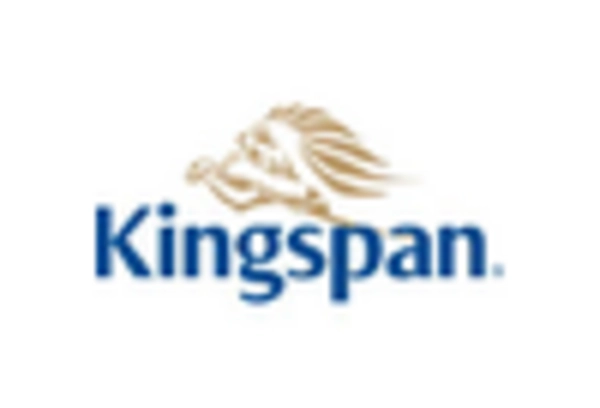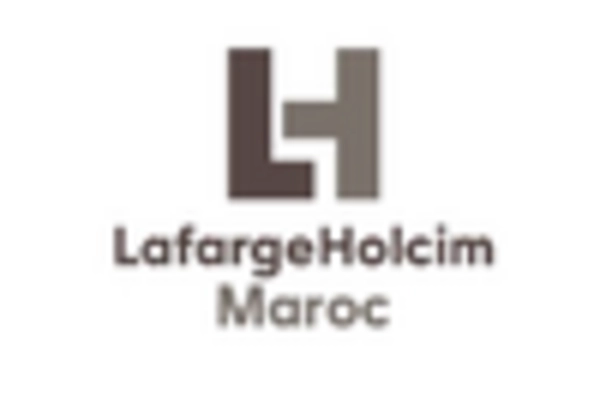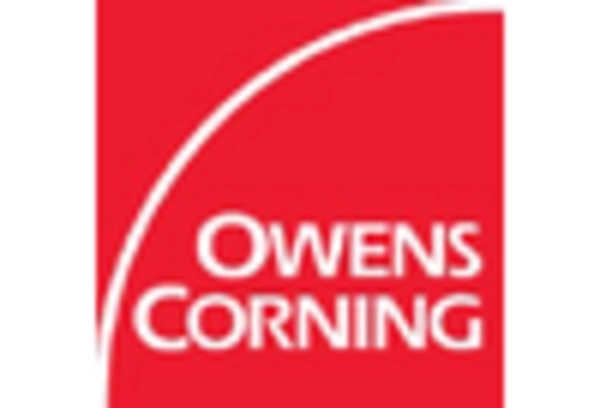Urbanization Trends
Urbanization trends are significantly influencing the Advanced Building Materials Market. As populations migrate towards urban areas, the demand for housing and infrastructure is escalating. This urban influx necessitates the development of high-density buildings and sustainable urban environments. Consequently, there is a growing need for advanced materials that can support these construction demands while ensuring durability and efficiency. The market is expected to expand as urbanization drives the need for innovative building solutions. Reports indicate that urban areas are projected to house nearly 68% of the world's population by 2050, further intensifying the demand for advanced building materials. This trend underscores the importance of developing materials that can withstand the challenges posed by urban living, such as space constraints and environmental impacts.
Regulatory Compliance
Regulatory compliance is a critical driver in the Advanced Building Materials Market. Governments worldwide are implementing stringent building codes and standards aimed at enhancing safety, sustainability, and energy efficiency. These regulations often mandate the use of specific materials that meet established performance criteria. As a result, manufacturers are compelled to innovate and adapt their product offerings to comply with these regulations. The market is witnessing a shift towards materials that not only fulfill regulatory requirements but also provide added value in terms of performance and sustainability. For instance, energy-efficient materials are increasingly favored due to regulations promoting reduced energy consumption in buildings. This compliance-driven approach is expected to propel the market forward, as stakeholders prioritize materials that align with both regulatory frameworks and consumer expectations.
Sustainability Initiatives
The Advanced Building Materials Market is experiencing a notable shift towards sustainability initiatives. As environmental concerns intensify, the demand for eco-friendly materials is surging. This trend is reflected in the increasing adoption of recycled and renewable materials in construction. For instance, the market for sustainable building materials is projected to grow at a compound annual growth rate of approximately 10% over the next five years. This growth is driven by both consumer preferences and regulatory pressures aimed at reducing carbon footprints. Consequently, manufacturers are innovating to create materials that not only meet performance standards but also align with sustainability goals. The emphasis on energy efficiency and waste reduction is reshaping the landscape of the Advanced Building Materials Market, making it imperative for stakeholders to adapt to these evolving demands.
Technological Advancements
Technological advancements are playing a pivotal role in the evolution of the Advanced Building Materials Market. Innovations such as 3D printing, nanotechnology, and smart materials are revolutionizing construction processes. For example, 3D printing technology is enabling the production of complex structures with reduced material waste and enhanced design flexibility. The integration of smart materials, which can respond to environmental changes, is also gaining traction. These materials can potentially improve energy efficiency and occupant comfort in buildings. The market is projected to witness a significant increase in the adoption of these technologies, with estimates suggesting a growth rate of around 12% annually. As these advancements continue to emerge, they are likely to redefine traditional construction practices and enhance the overall performance of building materials.
Economic Growth and Investment
Economic growth and investment are vital factors propelling the Advanced Building Materials Market. As economies recover and expand, there is a corresponding increase in construction activities across various sectors, including residential, commercial, and industrial. This growth is often accompanied by heightened investment in infrastructure development, which in turn drives demand for advanced building materials. Reports indicate that the construction sector is projected to grow at a rate of approximately 8% annually, fueled by increased public and private investments. Additionally, the rising disposable income levels in emerging markets are contributing to a surge in demand for high-quality building materials. This economic momentum is likely to sustain the growth of the Advanced Building Materials Market, as stakeholders seek innovative solutions to meet the evolving needs of the construction landscape.

















Leave a Comment